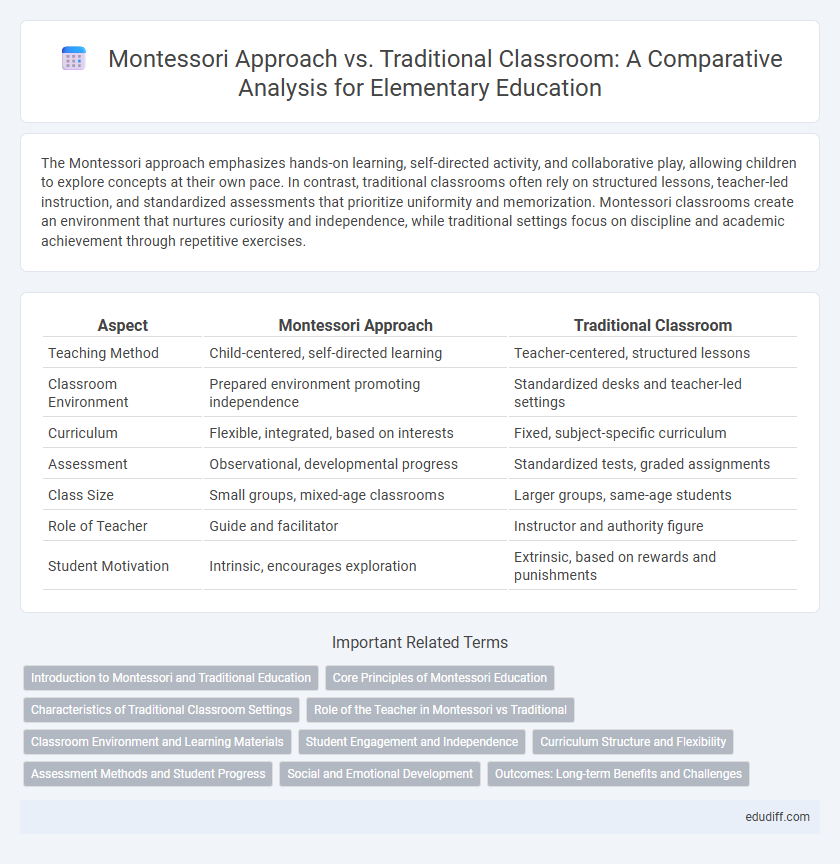The Montessori approach emphasizes hands-on learning, self-directed activity, and collaborative play, allowing children to explore concepts at their own pace. In contrast, traditional classrooms often rely on structured lessons, teacher-led instruction, and standardized assessments that prioritize uniformity and memorization. Montessori classrooms create an environment that nurtures curiosity and independence, while traditional settings focus on discipline and academic achievement through repetitive exercises.
Table of Comparison
| Aspect | Montessori Approach | Traditional Classroom |
|---|---|---|
| Teaching Method | Child-centered, self-directed learning | Teacher-centered, structured lessons |
| Classroom Environment | Prepared environment promoting independence | Standardized desks and teacher-led settings |
| Curriculum | Flexible, integrated, based on interests | Fixed, subject-specific curriculum |
| Assessment | Observational, developmental progress | Standardized tests, graded assignments |
| Class Size | Small groups, mixed-age classrooms | Larger groups, same-age students |
| Role of Teacher | Guide and facilitator | Instructor and authority figure |
| Student Motivation | Intrinsic, encourages exploration | Extrinsic, based on rewards and punishments |
Introduction to Montessori and Traditional Education
The Montessori approach emphasizes child-centered learning with hands-on activities and self-directed exploration, fostering independence and creativity. Traditional classrooms often follow a teacher-led curriculum focused on standardized instruction and memorization. Montessori education uses mixed-age classrooms to encourage peer learning, while traditional settings typically group students by age for structured lessons.
Core Principles of Montessori Education
Montessori education emphasizes self-directed learning, hands-on activities, and mixed-age classrooms, fostering independence and intrinsic motivation. Traditional classrooms typically follow a fixed curriculum, teacher-led instruction, and age-segregated groups, focusing on standardized testing and uniform pacing. Core principles of Montessori include respect for the child's natural development, sensory-based learning materials, and collaborative social interaction.
Characteristics of Traditional Classroom Settings
Traditional classroom settings feature teacher-centered instruction where educators lead lessons and students follow structured curricula. These environments emphasize standardized testing, rote memorization, and fixed schedules, often limiting individualized learning opportunities. Classroom management relies on rules and discipline to maintain order, prioritizing collective progress over personalized development.
Role of the Teacher in Montessori vs Traditional
In Montessori classrooms, teachers act as guides who facilitate self-directed learning, allowing students to explore materials at their own pace and develop independence. Traditional classroom teachers primarily deliver structured lessons and maintain control over the learning environment, focusing on uniform instruction and assessment. This distinction emphasizes student autonomy in Montessori settings versus teacher-led activities in traditional education.
Classroom Environment and Learning Materials
The Montessori approach features a carefully prepared environment with child-sized furniture and natural materials that promote independence and sensory exploration, allowing students to engage in hands-on, self-directed learning. In contrast, traditional classrooms use standardized desks and teacher-led instruction with textbooks and worksheets, emphasizing structured lessons and group activities. Montessori materials are designed to be self-correcting and encourage problem-solving, while traditional materials typically focus on rote memorization and teacher feedback.
Student Engagement and Independence
The Montessori approach fosters student engagement by encouraging hands-on learning and self-directed activities, promoting independence from an early age. In contrast, traditional classrooms often rely on teacher-led instruction, which can limit opportunities for students to make choices and take initiative. Research shows that Montessori students develop stronger problem-solving skills and greater motivation due to the emphasis on active participation and personalized learning paths.
Curriculum Structure and Flexibility
The Montessori approach offers a child-centered curriculum structure that emphasizes hands-on learning with flexible activities tailored to individual pace and interests. In contrast, traditional classrooms follow a fixed curriculum with standardized lesson plans and less room for personalized adaptation. This flexibility in Montessori education fosters self-directed exploration, enhancing deeper understanding and engagement.
Assessment Methods and Student Progress
The Montessori approach uses continuous observational assessments to monitor student progress, emphasizing individualized learning and self-paced mastery, while traditional classrooms rely on periodic standardized tests and grades to evaluate performance. Montessori assessments promote formative feedback and adapt instruction to each child's developmental needs, fostering intrinsic motivation. In contrast, traditional assessments often focus on summative evaluation, which can limit personalized growth and stress competition among students.
Social and Emotional Development
The Montessori approach fosters social and emotional development by encouraging collaboration, self-regulation, and empathy through mixed-age classrooms and hands-on activities that promote independence. Traditional classrooms often emphasize structured social interactions and teacher-led guidance, which can limit opportunities for personalized emotional growth. Research indicates children in Montessori settings tend to exhibit stronger social skills and greater emotional resilience compared to peers in conventional environments.
Outcomes: Long-term Benefits and Challenges
The Montessori approach fosters independence, creativity, and critical thinking, leading to enhanced problem-solving skills and intrinsic motivation in students. Traditional classrooms often emphasize standardized testing and structured learning, which can limit individual expression but provide clear benchmarks for academic achievement. Long-term benefits of Montessori include better social skills and adaptability, while challenges involve resource intensity and inconsistent implementation compared to the widely established traditional model.
Montessori Approach vs Traditional Classroom Infographic

 edudiff.com
edudiff.com